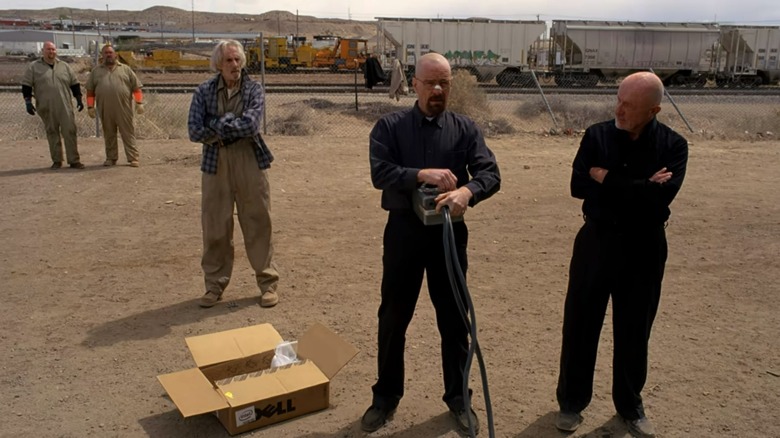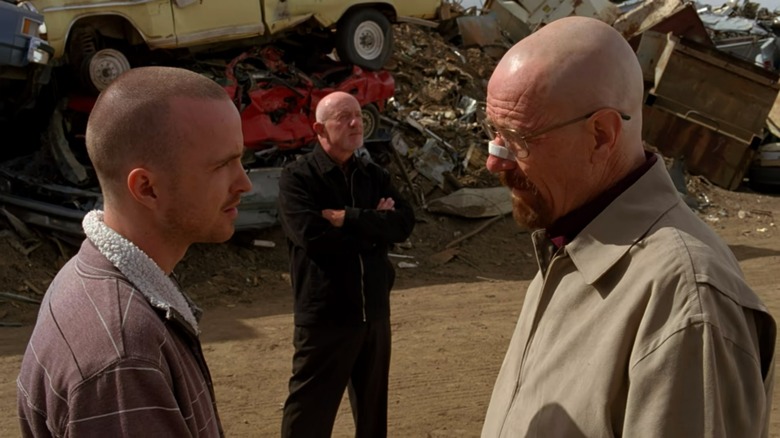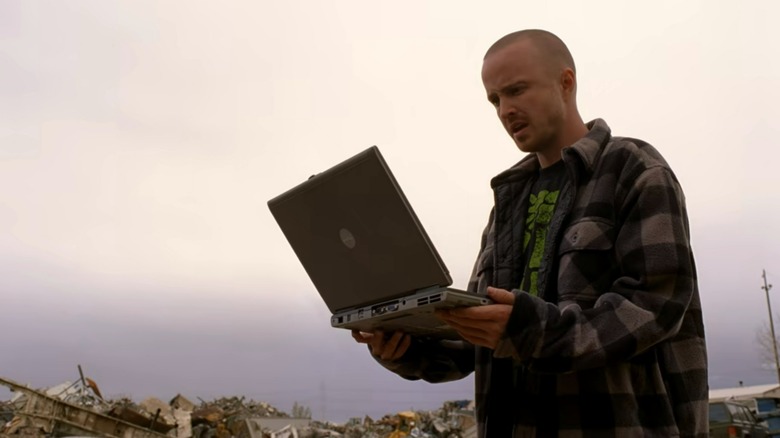Would Breaking Bad Season 5's Great Magnet Caper Actually Work In Real Life?
You know how it goes sometimes. A drug kingpin (Bryan Cranston's Walter White) and his partner in crime (Aaron Paul's Jesse Pinkman) narrowly manage to pull off the scheme of the century, plotting the downfall of their biggest benefactor-turned-foe (Giancarlo Esposito's Gus Fring) in as elaborate a hitjob as you'll ever see. But just as the coast seems clearer than it has in quite some time, with the maniacal killer out of the picture for good and his meth-making "superlab" burned to ashes (a location that a recent episode of "Better Call Saul" would retroactively add further layers to), the victors suddenly remember one pesky detail that could make all their desperate efforts for naught: the existence of incriminating surveillance footage on a single laptop hard drive.
Enter one of the most memorable (and meme-friendly) plots in the entire series, involving the show's quintessential knack for brilliant planning made up entirely on the fly, a daring nighttime raid on a police evidence warehouse, and, yeah, magnets, b***h! But as with many of the gripping events covered in the series, fans have spent years wondering whether the idea of surreptitiously driving a giant, modified electromagnet up to a police station, turning the amps up, and destroying all physical evidence could possibly work in real life.
Short answer? Quite a bit of artistic license was employed to ratchet up the tension, raising the stakes for our protagonists to perform yet another miracle. As it turns out, the dizzying array of complicated logistics, intentional plot contrivances, and plain ol' physics combine to make this fantasy wilt under further, more intensive scrutiny. But is that really the full story? Bigger and better minds have sought to solve the realism behind this classic "Breaking Bad" caper and the various findings are nothing short of fascinating.
Scientific skepticism
"Better Call Saul" may be hurdling towards the end of an over decade-long story, but fans will never get tired of debating the finer points of either "Breaking Bad' or "Better Call Saul" for years to come. The shelf life of the magnets saga from the original series proves this point emphatically, leaving countless fans and experts alike wondering whether such events could possibly be recreated in real life.
In an interview with The New York Times, series creator and showrunner Vince Gilligan admitted that he took a number of shortcuts to place the characters in such a specific situation in the first place, operating on a "Let's make life harder for these guys" approach to maximize the thrills. Interestingly, this scenario wasn't based on any real-life criminal escapade, but dreamed up entirely by the writer's room and, in part, by Gilligan's own film studies memories where a small magnet was used to erase audio tracks. In addition to revealing fun filming tidbits, like the use of cables (later digitally erased) to cause metal objects to fly around or securing the cooperation of Albuquerque's actual police department during filming, Gilligan admitted that such a plot was never devised to stand up to actual science.
In the immediate aftermath of the episode's airing back in July of 2012, Wired invited an actual physicist to ascertain the likelihood of any pair of ambitious criminals succeeding in such a ridiculous venture. Using the power of math and incredibly nerdy formulas, physicist Rhett Allain established that such a powerful device could erase the laptop hard drive's data from the distance shown in the episode ... theoretically, at least. Both Allain and Gilligan remarked that "Mythbusters" should attempt to answer this question once and for all — which is exactly what they did.
Myth busted
The premise of "Breaking Bad" and the undeniably devious mind of Walter White naturally put the show on the radar of Discovery's "Mythbusters" program, hosted by model makers and special effects gurus Adam Savage and Jamie Hyneman. The show actually tackled a couple of season 1 events in one special episode in 2013, notably the gruesome business of whether a corpse could actually dissolve in hydrofluoric acid (along with a bathtub) and if mercury fulminate crystals could actually blow up an entire floor of a building.
In 2019, "Mythbusters Jr." tackled the pressing question of unleashing the power of magnets on an unsuspecting evidence room lockup, with Gilligan appearing as a special guest to introduce the myth to Savage and his impressionable team of kids (all of whom, presumably, were given a stern talking to about the dangers of drugs, of course). Using a comparable electromagnet parked right up next to a mockup of the show's evidence room, however, the device proved insufficient to actually drag any metallic objects from their resting spots and pull them right through the air against the wall — failing to move even a nearby paperclip. The episode conclusively disproves the common assumption that the stronger a magnet is, the more distance it can exert its influence. Even junkyard magnets, as seen in that episode of "Breaking Bad," can lift enormous amounts of tonnage ... but only when in direct contact with them, as opposed to pulling them from across the length of an entire yard.
The "Mythbusters Jr." episode also busts the idea that the electromagnetic field could completely wipe out the hard drive data, as well. As it turns out, the magic of that "Breaking Bad" caper — and Jesse's boyish excitement — will have to live on in our imaginations.


